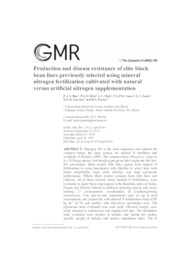Production and disease resistance of elite black bean lines previously selected using mineral nitrogen fertilization cultivated with natural versus artificial nitrogen supplementation.
Production and disease resistance of elite black bean lines previously selected using mineral nitrogen fertilization cultivated with natural versus artificial nitrogen supplementation.
Author(s): DIAS, P. A. S.; MELO, P. G. S.; MELO, L. C.; SOUZA, T. L. P. O.; FARIA, L. C. de; FERREIRA, E. P. B.; PEREIRA, H. S.
Summary: Nitrogen (N) is the most important soil nutrient for common beans; the main sources are mineral N fertilizers and symbiotic N fixation (SNF). The common bean (Phaseolus vulgaris) is a N fixing species, but breeding programs have neglected this fact. We investigates black seeded elite lines grown with mineral N fertilization or using inoculation with rhizobia to select lines with broad adaptability, high yield stability, and high agronomic performance. Fifteen black seeded common bean elite lines and cultivars, all of them selected under mineral N fertilization, were evaluated in major bean crop regions in the Brazilian states of Goiás, Paraná and Distrito Federal in different growing seasons and years, totaling 13 environments (combination of location/growing season/year). Two side-by-side experiments were set up in each environment, one exclusively with mineral N fertilization (total of 80 kg ha-1 of N) and another with Rhizobium inoculation only. The agronomic traits evaluated were seed yield, 100-seed weight, sieve yield, reaction to anthracnose and angular leaf spot. The nodulation traits evaluated were number of nodules and nodule dry matter, specific weight of nodules and relative nodulation index. The N source significantly affected seed yield, 100-seed weight and reaction to anthracnose. All lines produced a higher yield and had higher 100-seed weight under N mineral fertilization; but they were more resistant to disease when inoculated with rhizobia. The interaction between lines and N sources was significant for seed yield, sieve yield, and reaction to anthracnose. However, it did not affect selection of the best lines regardless of N source. The cultivars BRS FP403 and BRS Esteio are recommended for planting with either of the two N sources because they were the highest yielding and exhibited high adaptability and stability under both N supply systems. Selection of superior lines does not appear to depend on the source of N used during crop development. The lines BRS Campeiro and CNFP 15177 gave the highest nodulation index, indicating that these lines should be used in crosses with high yielding lines to produce lines with high seed yield and high nodulation, reducing possible yield losses in SNF systems compared to those that useonly mineral N fertilizer.
Publication year: 2020
Types of publication: Journal article
Unit: Embrapa Rice & Beans
Observation
Some of Embrapa's publications are published as ePub files. To read them, use or download one of the following free software options to your computer or mobile device. Android: Google Play Books; IOS: iBooks; Windows and Linux: Calibre.
Access other publications
Access the Agricultural Research Database (BDPA) to consult Embrapa's full library collection and records.
Visit Embrapa Bookstore to purchase books and other publications sold by Embrapa.

